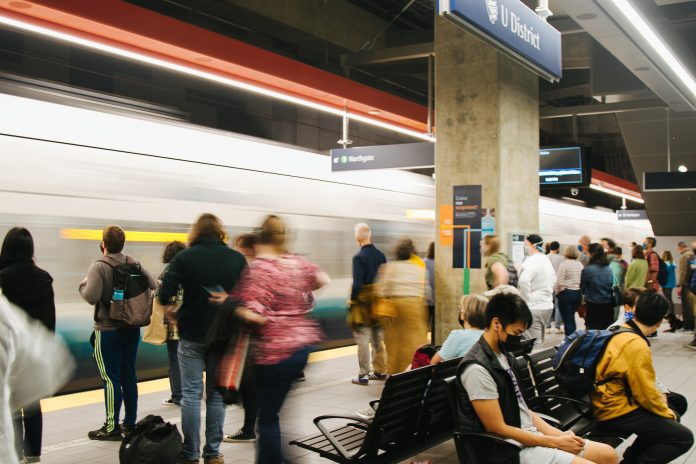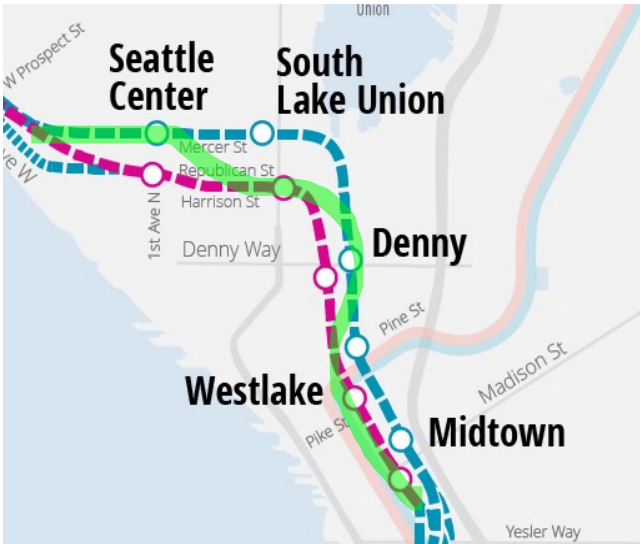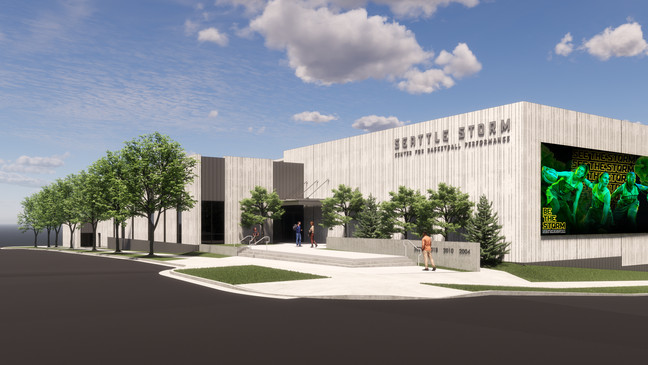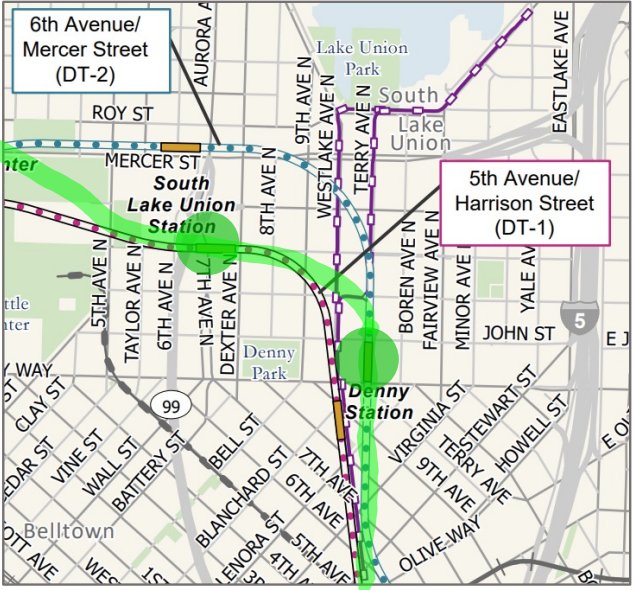
Stakeholders are demanding more information from Sound Transit, as is the Harrell Administration, as it unveils its alignment preferences.
Sound Transit is planning Seattle’s light rail future and many are worried about the direction the train is headed. This ranges from grassroots transit advocacy organizations like Seattle Subway and us at The Urbanist to very powerful business stakeholders. Sentiment seems to be widespread that Sound Transit isn’t really showing its work or leveling with riders and other stakeholders about the key decision points that will actually determine the fate of West Seattle Link and Ballard Link, which will bring 13 new or expanded light rail stations to Seattle in the 2030s.
Including all the addenda, the Draft Environmental Impact Statement (DEIS) for those two projects was more than 8,000 pages long but on some key issues it addressed very few questions.
Kylie Rolf, who is vice president of advocacy at the Downtown Seattle Association (and formerly Director of Major Initiatives and Legislative Affairs in the Durkan administration) expressed her organization’s frustration with the murkiness still in the agency’s plan on a recent meeting of the Downtown Community Advisory Group (CAG) — of which she is a member.
“This has been a little bit of difficult exercise for me and for others. Because if you’re coming at from the lens of economic development impacts, impacts to downtown residents, impacts to downtown businesses, arts and cultural organizations, in order to formulate meaningful opinions and comments, it’s pretty impossible to do with this level of information that’s contained in this DEIS,” Rolf said. “Things like construction timing and phasing throughout the segment, street closure phasing and duration, plans for pedestrian traffic and transit detours.”
John Marchione, the former Redmond Mayor who now represents the Public Stadium Authority, also complained about the low level of detail. Marchione said his organization would like to see more details about detours and small business impact mitigation before they determine a preferred alternative at the Chinatown-International District Station. Sound Transit did sketch out some rough concepts for detours in the DEIS, but Marchione said more structure and details for the plan would be needed beyond simply indicating alternate routes.
Other Downtown CAG members largely echoed those sentiments. Sabrina Villanueva, who is senior director of property management with mega-landlord Clise Properties, said the two-year closure of 4th Avenue would be unacceptable and hurt commercial activity. Amy Worthington, a commercial real estate advisor, agreed and argued the negative impacts to the street could linger long after construction. She contended that 3rd Avenue is still suffering from degraded urban design and commercial environment because of the construction of the original Downtown Transit Tunnel in the 1980s.
Complaining about construction impacts can lurch into the absurd. Did stakeholders think that a subway would instantly materialize as if by magical spell with no impact to cars and businesses on the surface? Impacts and detours are the inevitable toll of any major construction project. In Seattle, it appears some are not even willing to build a transformational 100-year rapid transit line without letting temporary impacts to car traffic to be the driving factor in our decisions.
Still, the consensus that Sound Transit hadn’t communicated its plan well or effectively honed in on a mitigation strategy was fairly resounding. Nonetheless, the process presses forward and Sound Transit still hopes to finalize the EIS on schedule despite the pushback and lack of consensus on some of the more controversial decisions.
Harrell backs Mercer Street Station in Uptown
Mayor Bruce Harrell has unveiled the City’s proposed official preferences on the light rail alignment and transmitted them to Alex Pedersen, who chairs the Seattle City Council’s transportation committee and is sponsoring the resolution that would make them the City’s official stance. The alignment preferences are still awaiting a vote from the rest of the council, but they may not prove an area where councilmembers want to expend political capital by bucking the mayor and wading into murky waters where most decisions come with controversy and powerful detractors.
In a recent Sound Transit Board meeting, Mayor Harrell revealed his administration’s preference for Mercer Street location in Uptown to avoid impacts to KEXP, other arts organizations, and performance venues in the Seattle Center. The resolution also backs Terry Avenue in Denny to avoid traffic impacts to Westlake Avenue, deviating from the agency’s preferred alternative. A four- to six-year-long closure of Westlake Avenue, which cuts through Amazon’s campus and is a major transportation artery for major employers and residents throughout North Downtown, has proven to be too tough a pill to swallow.
The Seattle Center Foundation submitted a letter opposing the Republican Street option and backing Mercer Street in hopes noise and construction disruptions would be less. Some arts organizations worried impacts from a Republican siting could put them out of business and also expressed worry about losing “legacy trees” on the Seattle Center campus, which the City’s presentation flagged as well, in addition to arguing the transit-oriented development (TOD) potential would be greater with Mercer.

The Urbanist backed the Republican Street alternative because riders would be able to get the surface quicker since the station depth is shallower and its location is on the on the doorstep of the pedestrianized Seattle Center complex rather than under a busy Mercer Street. “From a rider perspective, the Republican Street station is clearly superior,” I wrote in our DEIS rundown. Situated about 85 feet deep below a pedestrianized street, a Republican station should be able to provide elevators headed direct to the surface, although for some reason the agency says that is not in the plan yet.
Meanwhile, the Mercer Street alternative in Uptown is significantly deeper at about 110 feet, has no direct elevators to the surface, displaces more homes, and is part of a more expensive alignment for the Downtown section. A Mercer station would also require riders take more time getting to the surface — especially disabled riders — due to the greater depth and lack of direct elevators, but this aspect of the rider experience hasn’t been a primary concern during the process. If the City gets its way, the best hope for the Mercer site is to some incorporate some direct elevators between the platform and surface into the design, which would be tricky since the platform is planned to be directly below Mercer Street, and closing Mercer Street to cars or taking lanes doesn’t appear to be on the table. Reducing the station depth would also help.
Terry Avenue Denny Station garners Harrell and Pedersen’s support
The City’s supported its preference for Terry Avenue alternative for Denny Station by noting the construction impacts to the Seattle streetcar would be lessened and a long closure of Westlake Avenue would be avoided. Sound Transit’s preferred alternative (DT-1) would put the station underneath Westlake Avenue, requiring a long closure of the road as the station pit is excavated, the station constructed, and the road rebuilt.
In West Seattle Junction and Ballard, the City’s resolution backs tunnel options, in the case of Ballard, at 15th Avenue NW. Tunnel options may end up adding marginally to project cost, but it appears not nearly as much as initially projected. The DEIS showed elevated alignments for reaching Ballard and Junction were much more expensive that initial estimates, while costs for tunnel alternatives held relatively steady. This decreases the chances that Sound Transit will require third party funding to move forward with tunnel options. Seattle policymakers, thus, appear to be all in on tunnel alternatives.
Moving on to West Seattle, Harrell’s administration prefers the south crossing of the Duwamish River and the DEL-6 lower height Andover elevated pairing for Delridge Station to link to a retained cut station at Avalon and a medium tunnel Junction Station at 41st Avenue SW. Those West Seattle preferences mirror those put forward by The Urbanist. In SoDo, Harrell has backed the south surface option.
No decision yet at CID Station, but deepest stations rejected
Meanwhile, at the controversial Chinatown-International District Station, the City, like the Sound Transit Board, didn’t settle on a single preferred alternative. Mayor Harrell has criticized the very deep stations (about 190 feet deep) as untenable however, but the resolution didn’t land on other whether 4th Avenue or 5th Avenue was superior for the shallower alternatives. In a similar vein, King County Council Chair Claudia Balducci criticized the very deep options on the table and said every station should have escalators and stairs, not just elevators, as proposed in the very deep stations.
“Elliott Snake” concerns elevated
The City also failed to come to a decision at the South Interbay Station (also known as Smith Cove) and said the agency needed to provide more detail in order to guide their selection. The City’s presentation expresses a number of worries including lost turn lanes, the visual impact of elevated guideway, impacts to the tree-covered slope leading to Kinnear Park, landslide risk, roadway capacity on Elliott Avenue W during construction, and freight and maritime business impacts long-term. While noting greater public support for the Galer Street option (SIB-1), the resolution frets over what it calls the “Elliott Snake” formed by elevated rail crossing Elliott Way numerous times.
“SIB-1 and SIB-2 would create significant transportation and visual impacts associated with construction and operation of an elevated guideway that would cross Elliott Avenue West three times,” the City writes. “Impacts include structures placed in right-of-way, permanent removal of turn-lanes, and sightline obstructions for all roadway users in this high volume freight corridor.”
The Elliott “snake” issue also highlights a potentially odd choice of not just running the line down the middle of Elliott Way in a median, as is a common way to build high capacity transit worldwide but almost never done in the Puget Sound Region. This may not address all the visual clutter criticism, as some broadly reject the aesthetics of elevated transit. It might also cost a lane or two and magnify construction impacts to cars and freight, which is where some stakeholders concerns are fixated. But elevated light rail could have also been a cheaper and more elegant solution that fits in better to the cityspace once built — at least in some alternate reality Seattle we may never know.
Interbay Retain Cut Station could require taking the Seattle Storm Practice Facility
The City was more decisive in north Interbay and espoused a preference for the retained cut Interbay station that pairs with its preferred tunnel crossing of Salmon Bay and 15th Avenue tunnel station in Ballard. However, the resolution does express concerns about impacts to a planned Seattle Storm WNBA practice facility, which appears in the path of the tunnel portal. The City expressed hope the soon-to-open $60 million facility could be spared.

It’s not clear avoiding the facility is possible with the alternative, but the City will likely explore additional alternatives.
The resolution goes to the City Council’s transportation committee on Tuesday June 7th.
Correction: An earlier version of this article listed Kylie Rolf’s employer as the Seattle Metropolitan Chamber of Commerce rather than the Downtown Seattle Association. We apologize for the error.
Clarifications: The original version of this article described the Westlake Avenue closure as nearly a decade long, but the agency estimates the closure at four years, or six years if they opt to keep the streetcar open; so we removed our hyperbolic adjective. Sound Transit also says it does not have a specific estimate for how much more a Mercer Street station costs than a Republican Street station, but it is part of a more expensive alignment overall. We clarified that Republican Street station is not yet planned with a direct elevator to the surface even though it seem quite feasible for the location. We added mention that the agency estimates the 15th Avenue tunnel alternative is $200 million more expensive than the 14th Avenue tunnel alternative. We also clarified the Mercer Station is under Mercer Street and will offer entrances planned on both sides, so it is not technically “across” it.
Doug Trumm is publisher of The Urbanist. An Urbanist writer since 2015, he dreams of pedestrian streets, bus lanes, and a mass-timber building spree to end our housing crisis. He graduated from the Evans School of Public Policy and Governance at the University of Washington in 2019. He lives in Seattle's Fremont neighborhood and loves to explore the city by foot and by bike.



